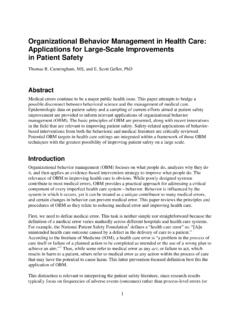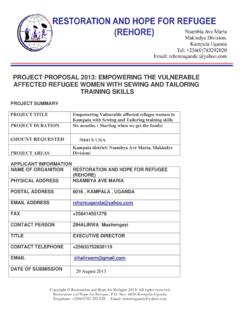Transcription of UNHCR’S STRATEGIC DIRECTIONS 2017–2021
1 UNHCR S STRATEGIC DIRECTIONS2017 2021 Front cover: Internally displaced Iraqi people at an aid distribution in Mosul, December 2016 UNHCR/IVOR PRICKETTUNHCR, 16 January 2017 UNHCR S STRATEGIC DIRECTIONS 2017 2021 UNHCR > UNHCR S STRATEGIC DIRECTIONS 2017 2021 32 UNHCR > UNHCR S STRATEGIC DIRECTIONS 2017 2021 Introduction This document describes the challenges and opportunities that characterize forced displacement in today s complex global environment, and sets out the STRATEGIC DIRECTIONS that UNHCR will pursue in the coming five years. It describes the approach that will shape UNHCR s work, including its commitment to put people first, to strengthen and diversify partnerships, to work across the entire spectrum of forced displacement, and to provide practical, concrete support to States to secure protection and solutions for refugees, the internally displaced and stateless people. It elaborates five core DIRECTIONS on which UNHCR will focus protection; responding in emergencies and beyond; promoting inclusion and self-reliance, including through the engagement of development actors; the empowerment of the people UNHCR serves; and the pursuit of document also describes the institutional changes UNHCR will undertake in order to pursue these DIRECTIONS , and to optimize its responsiveness, effectiveness and institutional the diversity of UNHCR s operations worldwide, the elements set out in this document are not a prescriptive list of priorities to be applied across all operations.
2 Their purpose is, rather, to chart an overall course in relation to major global challenges over the next five world in disarray 6 Rising to the challenge our approach 12 What we will do: five core DIRECTIONS 15 1. Protect 16 2. Respond 19 3. Include 22 4. Empower 24 5. Solve 26 Making it work 28 Hasansham IDP camp Iraq, November 2016. UNHCR/JORDI MATAS 54 UNHCR > UNHCR S STRATEGIC DIRECTIONS 2017 2021 Causes and consequences of forced displacement1 This figure includes million Palestinian refugees who fall within the competence of the end of 2015, over 65 million people worldwide were displaced from their homes by conflict and persecution - up from 37 million ten years ago, and the highest number seen in decades. The tally for the year included million people internally displaced by conflict, violence and human rights violations, over 21 million refugees,1 and more than three million asylum-seekers.
3 In 2015 alone, an estimated million people were newly displaced, including million inside their own countries and million refugees, and 500,000 new refugees also fled in the first half of 2016. Numbers are likely to continue to increase in 2017 and beyond if the circumstances driving displacement persist, or as communities currently trapped in enclaves or besieged as a deliberate tactic by parties to conflicts become able to move in search of safety. The immediate causes of refugee flows and internal displacement today are armed conflict, violence, insecurity and human rights abuses. Major conflicts have grown in intensity and are causing many more fatalities, particularly amongst civilians, than even five years ago. Continuing conflicts around the world some lasting for decades, some intensifying and very much in the public eye, others virtually forgotten have forced millions of civilians to flee their homes, often several times, with no clear-cut solutions in causes and characteristics of conflict are variable and complex.
4 Some of the most deadly and intractable recent conflicts have been complicated by forms of violent extremism. Criminality is also - increasingly - a cause or a result of conflict or violence, subverting institutions of governance that may already be non-inclusive, perceived as illegitimate, or simply weak. Most violent conflicts today are characterized by an utter disregard for civilian life, and the deliberate targeting of civilian populations A WORLD IN DISARRAYis commonplace. Other gross and systematic violations of human rights and international humanitarian law are also widespread, including, in the context of humanitarian action, through the obstruction of humanitarian access or the deliberate targeting of humanitarian workers. Against this background of protracted and escalating conflicts, the number of refugees returning home has been at a historical low. In 2014, fewer than 127,000 returned to their countries, and only 200,000 in 2015 - the lowest numbers in many years.
5 While numbers increased somewhat in 2016, this does not represent a general trend, and returns often took place in less than ideal circumstances and against a complex backdrop of ongoing protection challenges and limited prospects in countries of asylum. solutions for large numbers of internally displaced people have been similarly elusive; in many countries, they have been displaced not just once, but multiple times, because of their inability to find safety or a sustainable means for survival. Often, they remain disconnected from the rest of the population and find it hard to restart their lives. The consequences of the failure to find solutions for so many forcibly displaced people, or to provide them with opportunities to lead productive and meaningful lives in the meantime, are not only borne by the people themselves but also entail serious costs and risks for hosting communities and States. If conflict is the primary driver of forced displacement today, it is not the only cause.
6 Large numbers of people have also continued to flee their countries because of serious human rights abuses, including severe discrimination, weak rule of law and other aspects of bad and non-inclusive governance. Others are on the move because of acute poverty, the collapse of traditional livelihoods in a context of globalization and rapid urbanization, the effects of climate change, natural disasters, and environmental degradation which often exacerbate competition over scarce resources. Often these various factors overlap or reinforce others. The fact that ten million stateless people lack the fundamental rights associated with citizenship is a further source of instability and displacement. A WORLD IN DISARRAYF amilies displaced by fighting in the village of Shora, 25 kilometres south of Mosul, gather at an army checkpoint on the outskirts of Qayyarah. November 2016. UNHCR/IVOR PRICKETTUNHCR > UNHCR S STRATEGIC DIRECTIONS 2017 2021 76 UNHCR > UNHCR S STRATEGIC DIRECTIONS 2017 2021A WORLD IN DISARRAYP rotection in times of crisisThe impact of forced displacement today is highly asymmetrical.
7 Almost two thirds of those compelled to move by conflict, violence or persecution remain within the borders of their own countries, often amidst ongoing conflict in a broader context of state fragility, directly exposed to gross violations of international humanitarian law, and with limited access to protection and support. Addressing the complex protection needs of the internally displaced and restoring their rights is often critical to laying the foundations for greater stability and solutions for both IDPs and 2015, eighty-six per cent of all refugees of concern to UNHCR were in low and middle income countries close to situations of conflict. Often the level of international support these countries receive does not correspond to the scale of the responsibilities they shoulder or to the needs of the people they admit. Many continue to open their borders and to provide asylum and various forms of support to large numbers of refugees, often in circumstances in which they themselves lack the resources to cope or even to meet fully the needs of their own nationals.
8 Despite all the challenges, it is evident that the overall commitment to providing refugee protection strongly resonates in today s world and is deeply embedded in all cultures and , generous though the asylum practices of many front-line States have been, large numbers of refugees remain without solutions , without prospects, without the freedom and resources to rebuild their lives and take charge of their future. They include a growing number of refugee children, who today make up 51 percent of the world s refugees, some without family members, many without access to proper education and all without the anchor of a home, and large numbers of refugee women and girls who face multiple dangers in exile, including sexual exploitation and abuse. Moreover, patterns of displacement are also changing in a rapidly urbanizing world. While significant numbers of refugees and internally displaced people are still confined to camps or live scattered in rural areas, the number fleeing into urban settings has grown, further exacerbating problems of urban poverty and exclusion.
9 Today, six out of every 10 refugees falling under UNHCR s mandate live in urban of this contributes to the complex mix of factors that leads increasing numbers of forcibly displaced people, including unaccompanied and separated children, to move onwards within and beyond their own regions, in search of protection, livelihoods and the prospect of a future. With few legal opportunities available, many find themselves using the same dangerous land and sea routes as irregular migrants and encounter the same exploitation and life-threatening risks at the hands of smuggling and trafficking networks. These onward movements, although smaller in scale than the displacement impacting States in regions of origin, have had major political and social repercussions in the countries affected by them, and the commitment of States to provide asylum and uphold the rights of refugees has, in many cases, been weakened. Mixed flows of refugees and irregular migrants, with few options for migration through regular channels, have put pressure on asylum procedures, fuelling perceptions that asylum is being abused.
10 Meanwhile, economic uncertainty has given rise to negative attitudes towards immigrants more generally, amidst concerns over competition for jobs and social services, while acts of international terrorism have heightened anxiety about national security. In an increasing number of instances, shared social values and traditions are perceived to be under threat, levels of xenophobia are on the rise, and there is a growing politicization of migration and refugee issues. In this context, some countries have taken measures to restrict access to their territories, reduce the level of rights they provide to refugees, and even prevent them from reaching safety. Some have set up barriers to entry, including arrangements to transfer asylum-seekers and refugees to other countries where many of their rights cannot be properly assured. Others have introduced quotas on the number of applicants admitted to asylum procedures, or resorted to measures such as the unwarranted detention of asylum-seekers, confiscation of assets, increased visa requirements, and interdiction practices.
















